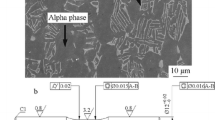Abstract
The feasibility of an accelerated test method on revealing the high cycle fatigue (HCF) limit stresses of a near alpha titanium alloy was successfully verified firstly during the rotary bending tests. The stress-controlled low cycle fatigue (LCF) tests at room temperature were then carried out over a range of maximum stresses and stress ratios to reveal the basic LCF strength. Finally, the core emphasis was focused on the influences of the predamage from LCF loadings on the subsequent HCF limit stresses corresponding to the life of 106 cycles. A total of eight levels of predamage from LCF with different stress levels, stress ratios, and proportions of LCF life were introduced, which resulted in obvious deterioration of the HCF stress limits (even under only 2% of expected LCF life). The fracture analysis exhibited that there were typical LCF failure characteristics in crack initiation regions of specimens under prior LCF loadings.







Similar content being viewed by others
References
W. Ren and T. Nicholas: Effects and mechanisms of low cycle fatigue and plastic deformation on subsequent high cycle fatigue limit in nickel-base superalloy Udimet 720. Mater. Sci. Eng., A 332(1), 236 (2002).
R.O. Ritchie, D.L. Davidson, and B.L. Boyce: High-cycle fatigue of Ti-6Al-4V. Fatigue Fract. Eng. Mater. Struct. 22(7), 621 (1999).
T. Nicholas and J.R. Zuiker: On the use of the Goodman diagram for high cycle fatigue design. Int. J. Fract. 80(2–3), 219 (1989).
T. Nicholas: Critical issues in high cycle fatigue. Int. J. Fatigue 21, S221 (1999).
N. Singh and V. Singh: Low cycle fatigue behavior of Ti alloy IMI 834 at room temperature. Mater. Sci. Eng., A 325(1), 324 (2002).
Y. Zeng, Y.Q. ZhaO, Q. Hong, and G.J. Yang: High cycle fatigue property of Ti-600 alloy at ambient temperature. J. Alloys. Compd. 509(5), 2081 (2011).
P.N. Singh, C. Ramachandra, and B.K. Singh: Room-temperature low-cycle fatigue behaviour of Ti-27Al-15Nb alloy. Bull. Mater. Sci. 18(2), 161 (1995).
S. Mall, T. Nicholas, and T.W. Park: Effect of predamage from low cycle fatigue on high cycle fatigue strength of Ti-6Al-4V. Int. J. Fatigue 25(9), 1109 (2003).
Z. Huang, Q. Wang, and D. Wagner: Effect of low cycle fatigue predamage on very high cycle fatigue. Theor. Appl. Mech. Lett. 2(3), 031007 (2012).
T.S. Srivatsan, M. Kuruvilla, and L. Park: A study at understanding the mechanisms governing the high cycle fatigue and final fracture behavior of the titanium alloy: Ti-4Al-2.5V. Mater. Sci. Eng., A 527(3), 435 (2010).
A. Dehghan-Manshadi, M.H. Reid, and R.J. Dippenaar: Effect of microstructural morphology on the mechanical properties of titanium alloys. J. Phys.: Conf. Ser. 240(1), 012022 (2010).
B. Li, N. Ma, and X.L. Liu: Fatigue properties of titanium alloy TA11 under multiaxial loadings with tension-bending vibration. Adv. Mater. Res. 887, 873 (2014).
China Aeronautical Materials Handbook Editorial Board, China Aeronautical Materials Handbook, Vol. 3, 2nd ed. (Standards Press of China, Beijing, 2002), p. 847.
D.C. Maxwell and T. Nicholas: A rapid method for generation of a Haigh diagram for high cycle fatigue. Fatigue Fract. Mech. 29, 626 (1999).
S.K. Paul, S. Sivaprasad, and S. Dhar: Ratcheting and low cycle fatigue behavior of SA333 steel and their life prediction. J. Nucl. Mater. 401(1), 17 (2010).
G. Totten: Fatigue crack propagation. Adv. Mater. Processes 166(5), 39 (2008).
Y. Brechet, T. Magnin, and D. Sornette: The Coffin-Manson law as a consequence of the statistical nature of the LCF surface damage. Acta Metal. Mater. 40(9), 2281 (1992).
S.M. Russ: Effect of LCF on HCF crack growth of Ti-17. Int. J. Fatigue 27(10), 1628 (2005).
ACKNOWLEDGMENTS
The research was supported by National Program on Key Basic Research Project (973 Program, No. 2015CB057400), National Natural Science Foundation of China (No. NSFC 51275023), and the Innovation Foundation of BUAA for PhD Graduates (No. YWF-14-YJSY-49).
Author information
Authors and Affiliations
Corresponding author
Rights and permissions
About this article
Cite this article
Jia, H., Yinyin, L., Duoqi, S. et al. Experimental investigation on HCF strength affected by predamage from LCF of a near alpha titanium alloy. Journal of Materials Research 29, 2748–2755 (2014). https://doi.org/10.1557/jmr.2014.309
Received:
Accepted:
Published:
Issue Date:
DOI: https://doi.org/10.1557/jmr.2014.309




